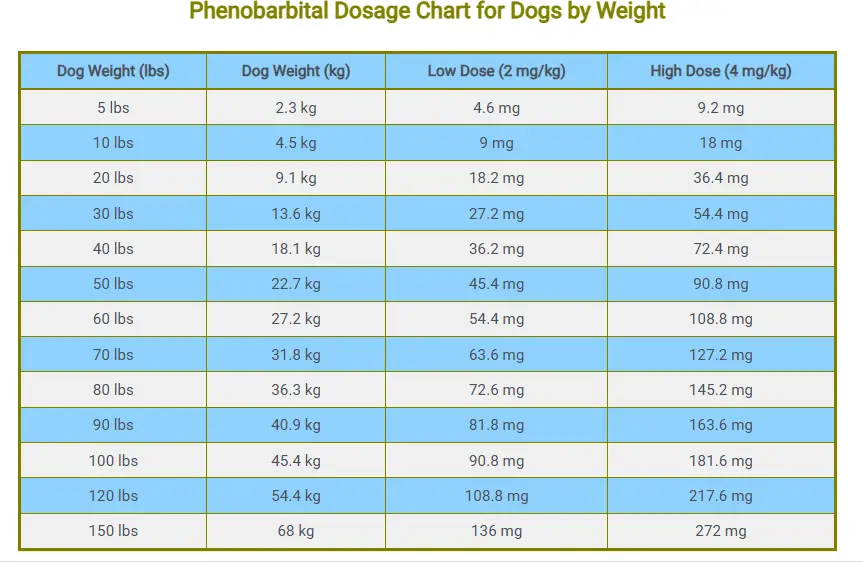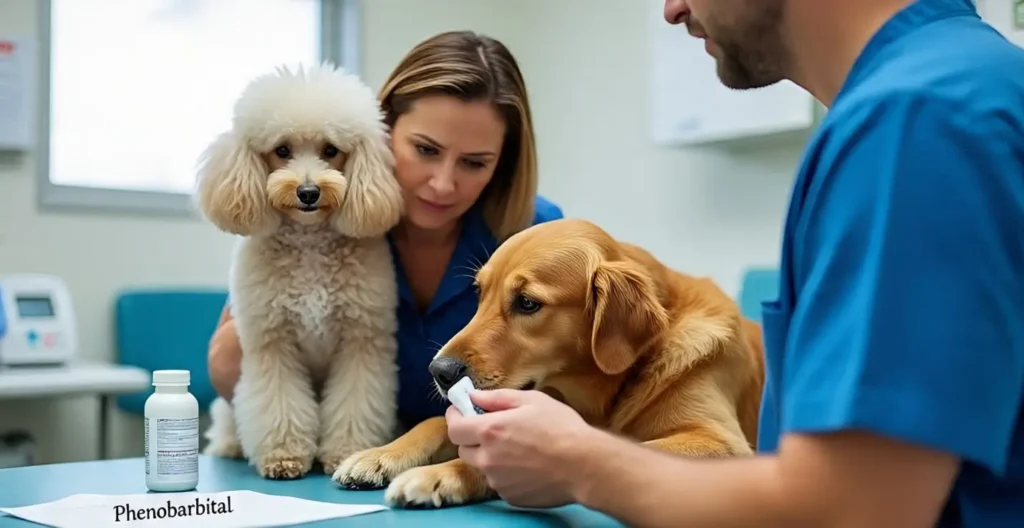Phenobarbital for dogs is a long-standing, barbiturate-based medication primarily used to control seizures in dogs. It works by depressing activity in the dog’s central nervous system, making it highly effective at minimizing or completely eliminating epileptic episodes. Veterinarians have used phenobarbital for decades due to its affordability, proven results, and ease of administration. It’s usually administered orally in tablet or liquid form, although injectable options are available in some scenarios, particularly in emergencies.
The medication is classified as a controlled substance, meaning it must be prescribed and closely monitored by a licensed veterinarian. While phenobarbital can’t cure the root causes of epilepsy or neurological disorders, it effectively manages the symptoms—mainly seizures. For most dogs with idiopathic epilepsy (where the cause is unknown), phenobarbital is often the first line of defense.
Phenobarbital can start showing its effects within hours, but optimal results usually develop over days or even weeks. Over time, the dog’s body adjusts to the medication, and consistent dosing becomes essential to prevent the recurrence of seizures.
Disclaimer: The information provided in this article is for educational and informational purposes only and is not a substitute for professional veterinary advice. Always consult your veterinarian for diagnosis, treatment, and guidance tailored to your pet’s specific needs.
Phenobarbital For Dogs Dosage
The typical dosage of phenobarbital for dogs is 2–4 mg per kilogram of body weight, administered orally twice a day. However, the exact dose must be customized by your veterinarian based on your dog’s individual needs and blood test results.
This is essential because canines metabolize phenobarbital at different rates, and monitoring blood levels ensures the medication is both safe and effective. Never adjust the dosage without veterinary supervision.
Phenobarbital Dosage Chart for Dogs by Weight
| Dog Weight (lbs) | Dog Weight (kg) | Low Dose (2 mg/kg) | High Dose (4 mg/kg) |
|---|---|---|---|
| 5 lbs | 2.3 kg | 4.6 mg | 9.2 mg |
| 10 lbs | 4.5 kg | 9 mg | 18 mg |
| 20 lbs | 9.1 kg | 18.2 mg | 36.4 mg |
| 30 lbs | 13.6 kg | 27.2 mg | 54.4 mg |
| 40 lbs | 18.1 kg | 36.2 mg | 72.4 mg |
| 50 lbs | 22.7 kg | 45.4 mg | 90.8 mg |
| 60 lbs | 27.2 kg | 54.4 mg | 108.8 mg |
| 70 lbs | 31.8 kg | 63.6 mg | 127.2 mg |
| 80 lbs | 36.3 kg | 72.6 mg | 145.2 mg |
| 90 lbs | 40.9 kg | 81.8 mg | 163.6 mg |
| 100 lbs | 45.4 kg | 90.8 mg | 181.6 mg |
| 120 lbs | 54.4 kg | 108.8 mg | 217.6 mg |
| 150 lbs | 68 kg | 136 mg | 272 mg |
Note: Always consult your veterinarian before starting or adjusting phenobarbital. Doses must be confirmed through blood level testing to ensure safety and effectiveness.
Phenobarbital Luminal® 20 mg/5 mL Oral Elixir (Liquid) Dosage Chart
| Dog Weight (lbs) | Dog Weight (kg) | Dosage Range (mg) | Oral Elixir Volume (mL) |
|---|---|---|---|
| 5 lbs | 2.3 kg | 4.6 – 9.2 mg | 1.15 – 2.3 mL |
| 10 lbs | 4.5 kg | 9 – 18 mg | 2.25 – 4.5 mL |
| 20 lbs | 9.1 kg | 18.2 – 36.4 mg | 4.55 – 9.1 mL |
| 30 lbs | 13.6 kg | 27.2 – 54.4 mg | 6.8 – 13.6 mL |
| 40 lbs | 18.1 kg | 36.2 – 72.4 mg | 9.05 – 18.1 mL |
| 50 lbs | 22.7 kg | 45.4 – 90.8 mg | 11.35 – 22.7 mL |
| 60 lbs | 27.2 kg | 54.4 – 108.8 mg | 13.6 – 27.2 mL |
| 70 lbs | 31.8 kg | 63.6 – 127.2 mg | 15.9 – 31.8 mL |
| 80 lbs | 36.3 kg | 72.6 – 145.2 mg | 18.15 – 36.3 mL |
| 90 lbs | 40.9 kg | 81.8 – 163.6 mg | 20.45 – 40.9 mL |
| 100 lbs | 45.4 kg | 90.8 – 181.6 mg | 22.7 – 45.4 mL |
Phenobarbital 15 mg Tablets Dosage Chart
| Dog Weight (lbs) | Dosage Range (mg) | Phenobarbit Tablet Count (15 mg) |
|---|---|---|
| 10 lbs | 9 – 18 mg | ⅔ – 1.25 tablets |
| 20 lbs | 18.2 – 36.4 mg | 1.25 – 2.5 tablets |
| 30 lbs | 27.2 – 54.4 mg | 1.8 – 3.6 tablets |
| 40 lbs | 36.2 – 72.4 mg | 2.4 – 4.8 tablets |
| 50 lbs | 45.4 – 90.8 mg | 3 – 6 tablets |
| 100 lbs | 90.8 – 181.6 mg | 6 – 12 tablets |
Phenobarbital 16.2 mg Tablets Dosage Chart For Dogs
| Dog Weight (lbs) | Dosage Range (mg) | Phenobarbital 16.2 mg Dosage |
|---|---|---|
| 10 lbs | 9 – 18 mg | 0.55 – 1.1 tablets |
| 20 lbs | 18.2 – 36.4 mg | 1.1 – 2.25 tablets |
| 50 lbs | 45.4 – 90.8 mg | 2.8 – 5.6 tablets |
| 100 lbs | 90.8 – 181.6 mg | 5.6 – 11.2 tablets |
Phenobarbital Luminal® 30 mg Tablets Dosage Chart
| Dog Weight (lbs) | Dosage Range (mg) | Luminal® 30 mg Dosage |
|---|---|---|
| 20 lbs | 18.2 – 36.4 mg | 0.6 – 1.2 tablets |
| 40 lbs | 36.2 – 72.4 mg | 1.2 – 2.4 tablets |
| 60 lbs | 54.4 – 108.8 mg | 1.8 – 3.6 tablets |
| 100 lbs | 90.8 – 181.6 mg | 3 – 6 tablets |
Luminal® Phenobarbital 32.4 mg Tablets Dosage Chart
| Dog Weight (lbs) | Dosage Range (mg) | Tablet Count (32.4 mg) |
|---|---|---|
| 20 lbs | 18.2 – 36.4 mg | 0.56 – 1.12 tablets |
| 50 lbs | 45.4 – 90.8 mg | 1.4 – 2.8 tablets |
| 100 lbs | 90.8 – 181.6 mg | 2.8 – 5.6 tablets |
Phenobarbital 60 mg Tablets Dosage Chart
| Dog Weight (lbs) | Dosage Range (mg) | Phenobarbital 60 mg Tablet Dosage |
|---|---|---|
| 30 lbs | 27.2 – 54.4 mg | 0.45 – 0.9 tablets |
| 50 lbs | 45.4 – 90.8 mg | 0.75 – 1.5 tablets |
| 100 lbs | 90.8 – 181.6 mg | 1.5 – 3 tablets |
Luminal® 64.8 mg Tablets Dosage Chart
| Dog Weight (lbs) | Dosage Range (mg) | Luminal® 64.8 mg Dosage |
|---|---|---|
| 30 lbs | 27.2 – 54.4 mg | 0.4 – 0.85 tablets |
| 50 lbs | 45.4 – 90.8 mg | 0.7 – 1.4 tablets |
| 100 lbs | 90.8 – 181.6 mg | 1.4 – 2.8 tablets |
Phenobarbital 97.2 mg 100mg Tablets Dosage Chart For Dogs
| Dog Weight (lbs) | Dosage Range (mg) | Phenobarbital 97.2 mg | Phenobarbital 100mg |
|---|---|---|---|
| 50 lbs | 45.4 – 90.8 mg | 0.47 – 0.93 tablets | 0.45 – 0.9 tablets |
| 100 lbs | 90.8 – 181.6 mg | 0.93 – 1.86 tablets | 0.9 – 1.8 tablets |
Note: Always round to practical dosing with vet approval. If exact dosing isn’t possible with available tablet strengths, your vet may prescribe a combination of tablets or the liquid form for precise administration.
Why Is It Phenobarbital Prescribed for Dogs?
Phenobarbital is primarily prescribed to treat:
- Idiopathic epilepsy
- Seizures of unknown origin
- Cluster seizures
- Status epilepticus (emergency, continuous seizures)
Veterinarians often choose phenobarbital because it’s been extensively studied, has predictable effects, and offers measurable therapeutic levels through blood tests. This allows for fine-tuning of the dosage based on a dog’s response.
When a canine starts having repeated seizures—defined as two or more in a month—or a single severe seizure lasting longer than five minutes, vets may immediately consider phenobarbital. It’s particularly helpful when used early in a dog’s epileptic journey to prevent the condition from worsening or becoming harder to manage.
Common Causes of Seizures in Dogs
Epilepsy is one of the leading neurological disorders in dogs, affecting around 1 in 20 canines. Seizures in canines can result from a wide range of causes, such as:
- Genetic predisposition (common in breeds like Beagles, Labradors, German Shepherds)
- Brain tumors or trauma
- Liver disease (hepatic encephalopathy)
- Toxins like antifreeze, chocolate, or xylitol
- Metabolic disorders (hypoglycemia, kidney failure)
- Infections affecting the brain (meningitis or encephalitis)
Understanding the root cause of seizures is critical before starting any long-term medication like phenobarbital. Often, extensive testing—bloodwork, MRIs, and spinal taps—are required to rule out underlying conditions.
How Phenobarbital Helps Manage Epilepsy
Phenobarbital controls seizures by enhancing the effect of GABA (gamma-aminobutyric acid), a neurotransmitter that inhibits nerve activity. This action calms down electrical impulses in the brain that trigger seizures. It essentially “slows down” the hyperactive parts of the nervous system, allowing the brain to stabilize.
Unlike some other seizure medications, phenobarbital offers a predictable absorption rate and reliable blood-level tracking, which makes it easier for vets to tailor the dosage. It’s also less expensive than newer alternatives like levetiracetam for dogs or zonisamide fo dogs, which is a major consideration for long-term treatment.
Phenobarbital isn’t a cure, but it can reduce seizure frequency dramatically, and in many canines, it eliminates them altogether when dosed correctly. The key to success is accurate, consistent dosing and careful monitoring.
How Phenobarbital Works in Dogs
Phenobarbital binds to GABA receptors in the brain and increases the duration that the chloride ion channel stays open. This process results in hyperpolarization of the neuron, making it less likely to fire. In simple terms, it calms the brain’s electrical storm that causes seizures.
This action happens relatively quickly once the medication is absorbed, but it requires a steady buildup in the system to reach therapeutic levels—usually within two weeks. Once in the bloodstream at the right concentration, it helps maintain stability in the brain and prevent the over-excitation that leads to seizures.
It’s important to note that phenobarbital’s effects aren’t just neurological. The liver is the primary organ responsible for metabolizing this drug, which is why liver enzyme tests are routinely done in dogs undergoing long-term treatment.
Duration and Onset of Effect
After oral administration, phenobarbital generally starts to take effect within 30 minutes to several hours. However, it may take 1–2 weeks to reach steady-state levels in the dog’s bloodstream. This is why veterinarians often do follow-up blood work within the first month to ensure the furry friend is in the therapeutic range (typically 15–45 µg/mL).
Phenobarbital has a relatively long half-life—up to 96 hours in some canines—which means it doesn’t need to be dosed multiple times a day in most cases. Typically, it’s given every 12 hours. This helps maintain a consistent blood level and reduces the likelihood of breakthrough seizures.
Factors Affecting Phenobarbital Dosage
Dog’s Weight
Weight is one of the most critical factors when calculating phenobarbital dosage. Dosage is typically expressed in mg per kilogram (mg/kg) of body weight.
Heavier dogs don’t always require proportionally higher doses due to differences in metabolism, so adjustments are often needed based on blood level monitoring.
Age, Breed, and Health Status
Younger puppies typically metabolize medications faster, requiring more frequent monitoring and potentially higher doses. Older dogs or those with liver issues may need reduced doses or alternative treatments due to the risk of hepatic damage.
Certain breeds may have genetic predispositions that affect how they respond to phenobarbital. For instance, Border Collies and Australian Shepherds are known to be more sensitive to many medications.
Canines with pre-existing liver, kidney, or heart conditions need special consideration, and the vet may opt for a lower starting dose with closer monitoring.
Administering Phenobarbital to Dogs
Getting your furry friend to take phenobarbital consistently is half the battle. Here are some tried-and-true methods:
- Hide the pill in food: Peanut butter, cheese, pill pockets, or a bit of meat can work wonders.
- Use flavored compounded versions: Your vet can prescribe liquid phenobarbital flavored with chicken or beef.
- Establish a routine: Give the medicine at the same time every day, 12 hours apart, to maintain steady blood levels.
- Reward afterward: Positive reinforcement helps your dog associate medication time with good things.
If your canine spits out the pill or resists, ask your vet for a liquid form or a different administration method. Some puppies may even need training to accept pills or syringes.
Always double-check you’re giving the right dose. Too much can lead to overdose symptoms (lethargy, wobbliness, sedation), and too little can leave your dog vulnerable to seizures.
Oral vs. Injectable Forms
While most dogs are prescribed oral phenobarbital in tablet or liquid form, there are injectable versions available—usually reserved for emergencies or hospitalized cases.
- Oral tablets: Most common form, typically 15 mg, 30 mg, 60 mg, 100 mg tablets.
- Oral liquid: Useful for small dogs or picky eaters; requires accurate measurement.
- Injectable: Used in acute seizures (status epilepticus) or during initial hospital treatment.
The oral route is almost always used for long-term management. Tablets are cost-effective, easy to dose, and readily available.
Side Effects of Phenobarbital in Dogs
Phenobarbital, while effective, does not come without side effects. When your dog starts this medication, it’s not unusual to see mild to moderate symptoms during the adjustment period. Common side effects include:
- Sedation or drowsiness: Many dogs appear groggy or lethargic during the first few weeks. This often improves as their body adjusts.
- Increased thirst and urination: Your dog may drink and urinate more than usual. Frequent potty breaks are a must.
- Increased appetite: Some dogs may become noticeably hungrier. Watch for weight gain and adjust meals accordingly.
- Ataxia: This is a loss of coordination or “wobbly” walking, usually more pronounced in the early stages.
These side effects are generally manageable and fade within a few weeks. However, they should always be reported to your vet, especially if they worsen or persist.
Signs of Phenobarbital Toxicity in Dogs
While rare, more severe side effects can occur. These include:
- Liver toxicity: Watch for yellowing of the eyes or gums (jaundice), vomiting, loss of appetite, or unusual lethargy.
- Bone marrow suppression: Uncommon but serious, it can reduce red or white blood cells.
- Allergic reactions: Hives, facial swelling, or breathing difficulty—seek emergency help immediately.
- Behavioral changes: Aggression, anxiety, or confusion may indicate neurological impact.
Routine blood tests are your best defense. They allow early detection of liver changes or blood abnormalities before they become life-threatening. If liver toxicity is confirmed, your vet may reduce the dose or transition your dog to another medication.
You should never adjust or stop the medication without veterinary guidance. Sudden withdrawal can cause dangerous rebound seizures.
Drug Interactions and Contraindications
Phenobarbital is known to interact with a wide range of drugs. Some interactions can lower the effectiveness of one or both medications, while others may increase the risk of side effects. Important interactions include:
- Steroids (e.g., prednisone): Can reduce phenobarbital effectiveness.
- NSAIDs (e.g., Rimadyl, Meloxicam): May increase liver stress.
- Antifungals (e.g., ketoconazole): Can increase phenobarbital levels.
- Antibiotics (e.g., doxycycline): May impact drug metabolism.
Always inform your vet of all medications and supplements your dog is taking, including over-the-counter items and natural remedies. This allows them to adjust doses or select safer alternatives.
Conditions That May Conflict with Phenobarbital
Phenobarbital should be used cautiously—or not at all—in dogs with:
- Liver disease
- Kidney dysfunction
- Anemia or other blood disorders
- Pregnancy (may affect fetal development)
If your dog has any of these conditions, your vet will likely consider other anticonvulsants like zonisamide or levetiracetam. Some dogs may tolerate phenobarbital with additional liver support (e.g., SAM-e, milk thistle), but only under strict veterinary supervision.
FAQs
Can I give my dog phenobarbital without a prescription?
Absolutely not. Phenobarbital is a controlled substance and requires a prescription from a licensed veterinarian. Giving it without proper guidance is not only illegal but also extremely dangerous for your dog. Dosage must be tailored specifically to your pet’s weight, health condition, and seizure history.
How soon will I see results after starting phenobarbital?
Some dogs begin to show improvement in seizure control within hours to days, but optimal blood levels can take up to 2 weeks. It’s essential to be patient and continue administering the medication as directed while monitoring for side effects and improvements.
What happens if I miss a dose?
If you miss a dose, give it as soon as you remember. However, if it’s close to the time of the next scheduled dose, skip the missed dose—don’t double up. Consistency is key, so set reminders or use a pill organizer to avoid this.
Can phenobarbital cure my dog’s epilepsy?
Phenobarbital does not cure epilepsy, but it is highly effective at controlling seizures and improving quality of life. Many dogs live long, happy lives on phenobarbital with regular monitoring and proper care.
Is it safe to combine phenobarbital with other seizure medications?
Yes, phenobarbital is often used in combination with other anticonvulsants like potassium bromide, levetiracetam (Keppra), or zonisamide if seizures are not well controlled with phenobarbital alone. However, this should only be done under a veterinarian’s supervision due to the risk of drug interactions.
Final Thoughts
Phenobarbital remains one of the most trusted and widely used medications for managing epilepsy and seizures in dogs. Its reliability, affordability, and established track record make it a go-to treatment for veterinarians across the globe. However, this powerful drug demands respect—dosage must be carefully calculated, administered consistently, and monitored closely through regular blood work and vet checkups.
Whether your dog is newly diagnosed or has been living with epilepsy for years, understanding how phenobarbital works—and how to use it properly—can make a world of difference. Always collaborate with your veterinarian, be vigilant about side effects, and never adjust the dose without professional guidance.
With the right management strategy, many dogs can enjoy seizure-free lives or significantly reduced episodes, allowing them to run, play, and snuggle like any other pup.











![Can Dogs Eat Blood? 7 Side Effects [Expert Opinion]](https://petskor.com/wp-content/uploads/2022/04/Webp.net-resizeimage-12.jpg)
